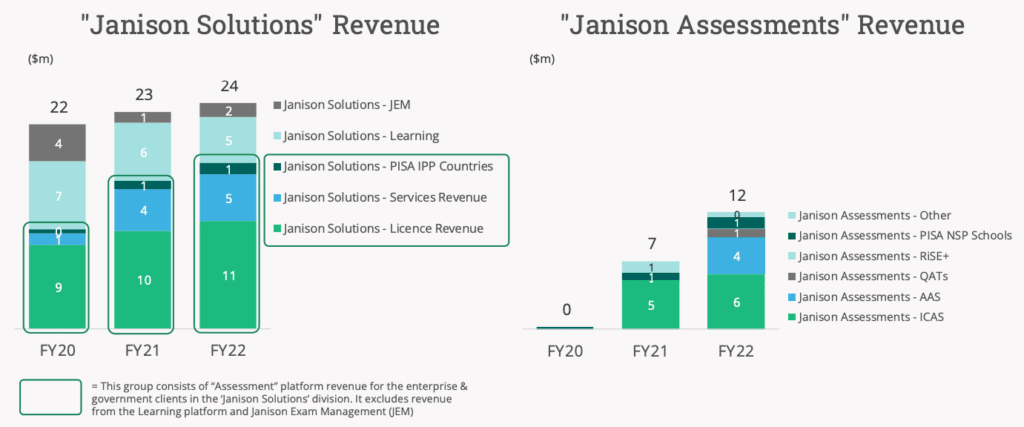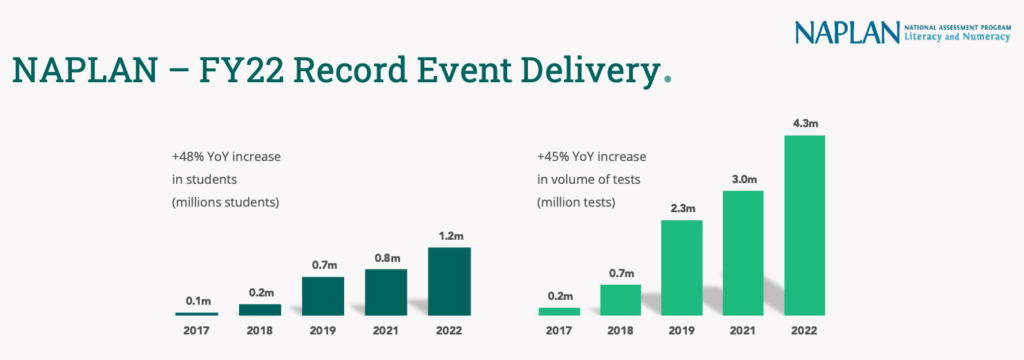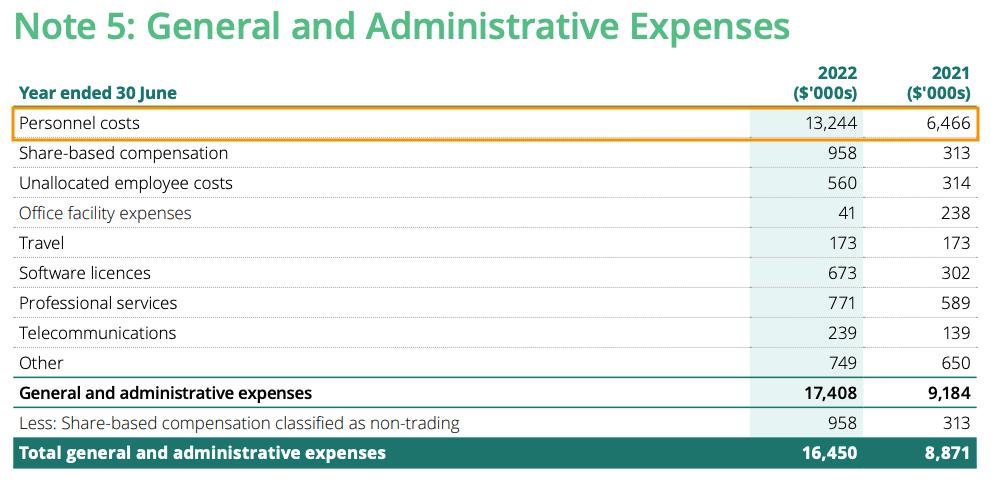The Janison (ASX: JAN) results revealed revenue grew 20%, gross margins lifted from 55% to 64% but net loss after tax fell from $3.2 million to $9.1 million. These Janison results show ample cash of $11.8 million and no long-term debt, but Janison is still liable for around $7.3 million in outstanding payments for the recent acquisitions of Academic Assessment Services (AAS) and Quality Assessment Tasks (QATs). At the time of writing the Janison share price is down slightly to 41.5 cents, giving it a market capitalisation of about $98 million.
Operating cash flow went backwards from $4.4 million to $1.4 million, due to the lift in new employees at the senior management and executive levels and higher short-term incentive payments relative to FY21. Management advised they are aiming to be net cash flow positive by FY23 when an analyst probed on the call. Management seemed certain about achieving positive operating cash flow but did not confirm guidance for net cash flow.
Behind the Janison Results Chalkboard
Management devoted a lot of the earnings call to highlight the upward trajectory of the top line and gross margins.

Janison’s past growth has historically been driven by past acquisitions and a lot of its recent success has been due to ICAS Assessments. Whilst revenue grew 20%, a lot of the heavy lifting was carried out by the AAS and QATs acquisitions, which contributed $4.8 million in revenue. This means Janison only generated $1.3 million in organic revenue growth.
It was hard to compare the breakdown of the Janison FY 2022 revenue with past years because management decided to change the segment composition. Rather than splitting the revenue reporting based on the type of product and service, management prefers to report the segments in accordance with the type of end customers, being enterprise and retail. Management explained this was a better reflection because of the recent acquisitions, which are more focused on providing paper-based assessment content.
This isn’t the first time management has altered the way it presents the revenue segment breakdown. In FY19, it acquired LTC, an end-to-end exam management services business, which was reported as a separate segment until it was included under Assessment Services in FY21.
Whilst there is nothing wrong with this, it makes it difficult for investors to monitor the performance of each segment. I personally consider this as a negative and I value management teams who consistently present clear and comparable results. Consistent reporting style makes it easier to measure performance as a shareholder. The recent results reported by PWR Holdings (ASX: PWR) are a great example of management making the effort to make it easier for investors to follow its performance.
As a Janison shareholder, these results present an opportunity to revisit my investment thesis. My thesis was partly premised on the Programme for International Student Assessment (PISA) segment acting as the long-term game changer for Janison. Despite PISA being rolled out across 17 out of the 90 addressable countries, it has hardly moved the revenue dial as seen below.

The problem with PISA is that it is only offered to 15-year-olds near the end of their compulsory education. As a result, in order to drive more revenue, Janison needs to lock in more schools. These schools are only going to pay somewhat a similar fee every year as there is no need to request more PISA tests.
Compare this to the ICAS, which is a leading digital assessment for children looking to break into selective schools. Anyone can take this test, there is greater revenue acceleration potential because as competition for selective school spots heats up, the demand for this test rises. Students can also pay for more tests to get more practice. Ultimately, the spend per customer potential is greater with ICAS.
In the Jansion FY 2022 results, I was quite fascinated as to why Janison wasn’t able to reap a lot more than it did, after delivering a record number of NAPLAN digital online tests pictured below.

As I understand it NAPLAN is an enterprise B2B licence agreement, and it doesn’t automatically benefit from the upside in volumes. However, a new contract renewal could reel in price increases given Janison’s successful delivery of the digital exams to date.
Whilst PISA isn’t looking like it’s going to be the game changer for Janison, its new Parent SaaS product Rise Plus could be it. It provides parents and tutors with K-12 assessment content to help advance a child’s education and is priced with annual or monthly subscriptions. The market for this service is supposedly 800,000 households in Australia.
The opportunity is there, but it’s still early days, I’ll be keeping a close eye on the performance of this segment. Selling at home online assessments by subscription may prove difficult, because for most families the regular use of online training assessments would be more of a phase than a permanent feature of childhood.
Janison FY 2022 results show expanding opex
Operational expenses have doubled since FY19, and a lot of these costs relate to marketing and bringing in top-level executives and senior management. This ramp in operating costs is the key underlying reason for Janison’s inability to achieve profitability.
The Janison FY2022 results show operating expenses surged by $7.7 million (56%) to $21.3 million. To mangement’s credit, they listed the key items that drove operating expenses but interestingly listed the recent acquisitions of QATs and AAS at the top.

Fortunately, this is broken down in the Janison FY2022 results and we can see that the doubling of personnel costs was the biggest contributor. This could have been highlighted more clearly on slide 17, which only put a number on the acquired Opex.

So, of the $7.7 million lift in opex, $6.77 million related to salaries, benefits and bonuses. It’s understandable to see a growth company go on a hiring spree to bring in more revenue, but we are yet to see meaningful traction given organic revenue growth was only $1.3 million.
I conducted a high review of the employees section on the Janison LinkedIn company page and company website. I noticed there are quite a lot of leaders across the organisation and I would argue some positions are crossing over each other like the Head of Commercial and Head of Customer Success.
Some of the other interesting titles I came across include; Chief Academic Officer, Culture Ambassador, Head of Commercial, Head of Projects, Digital Marketing Executive, Group Executive – Educational Assessments, Head of Assessment Content, Educational Assessments, Head of Customer Success, Head of Customer and Event Support and Head of Finance Transformation.
On the outset and without diving deeper to the organisational structure, it appears very top-heavy, suggesting higher salaries are required to retain such staff. Also, the wide range of division heads and leaders makes it seem like a complex organisational and reporting structure is in place.
The level of employee expenditure remains the biggest cost to Janison across the top line and bottom line. If Janison continues to show signs of top-heavy recruitment, I may consider it thesis-busting.
How Much Are Janison Shares Worth?
The Janison FY2022 results do not show signs of sustaining long-term profitability, with a strong focus placed on growing revenue and improving gross margins. The signs of scalability are not there yet in my opinion, so this makes it difficult to forecast future free cash flow. Even though management advised they are aiming to achieve net cashflow positive by FY23, this is only a target and shouldn’t be treated as guidance.
Management only left around 10-15 minutes for Q&A and I don’t think guests were able to submit questions. Previously, management allowed anyone to submit questions in the Microsoft Teams meeting chatbox, but this time, I couldn’t see such an option. This, along with the change in revenue segment reporting, and the lift in top-level salaries has left a sour taste in my mouth.
Edit: Please note that some people were able to ask questions, so my experience may have been an outlier.
My lower confidence in management has led me to carry out more research into any comparable companies that have tasted success. To date, it’s been difficult to find any successful educational assessment companies to hang my hat on. For example, recently listed Instructure Holdings Inc (NYSE: INST) is still not profitable despite recording more than $400 million in revenue and sustaining gross margins between 60 to 70% over the last five years.
I continue to hold Janison shares because the market opportunity continues to be attractive, especially in a structurally growing industry like digital assessments. And it has no debt. However, I would like to dig deeper into some of the negative points in the article above, before making a decision on whether to keep my current holding. Overall this set of results was a negative for me.
At the moment, sentiment is historically low based on both Enterprise to Revenue and Price to Sales multiples. The current EV/Revenue multiple is around 2.16x and the P/S multiple is 2.45x compared to historical means of 3.19x and 3.43x respectively. For now, I’ll have to reflect on my position.
Did you find this article useful? Sign up to receive access to hidden, Free content like this!
Disclosure: the author this article owns shares in Janison Education (ASX: JAN) and will not trade Janison shares for 2 days following this article. This article is not intended to form the basis of an investment decision. Any statements that are advice under the law are general advice only. The author has not considered your investment objectives or personal situation. Any advice is authorised by Claude Walker (AR 1297632), Authorised Representative of Equity Story Pty Ltd (ABN 94 127 714 998) (AFSL 343937).